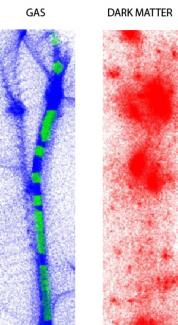Long, long ago galaxies now far away formed around ravenous black holes scattered throughout the Universe. Some 12.5 billion years later, JILA scientist Gayler Harford and Fellow Andrew Hamilton have identified the superhighways that funneled gas into some of the nascent galaxies. These thruways not only routed gas to feed the monster black holes, but also supplied raw materials for the billions and billions of stars that have illuminated those galaxies ever since.
The cosmic gas-transporting superhighways were filaments of ordinary matter that extended outwards from primordial galaxies and often linked entire strings of galaxies, according to simulations performed by Nick Gnedin of Fermilab and analyzed by Harford. Under favorable conditions in the simulation, the filaments formed long cylinders of gas at uniform temperatures, typically 10,000 to 20,000 K. The simulations suggest that the properties of the gas entrained in the filaments are far more important in determining filament structure than any nearby dark matter.
Haloes of dark matter surround most galaxies. Scientists have long thought dark matter’s role to be so critical to galaxy formation that the structure and behavior of nearby gas clouds could be ignored in models of galaxy formation. However, Harford’s results suggest that the gas hitchhiking along the filaments into the core of galaxies may be more important than dark matter in determining whether an emerging galaxy can pull in enough gas to form stars.
Many of the galaxies analyzed by Harford do not have intergalactic filaments attached to them. Such galaxies may be unable to accumulate enough gas to form stars. Harford says that there may be a new class of galaxies in the Universe that have not been detected because they are not luminous.
There may even be some of these dark galaxies near our own Milky Way. The standard model of cosmology predicts many more satellite galaxy haloes around the Milky Way than the galaxies we see. According to Harford, the galaxies may well be there. We just can’t see them.



 The Physics Frontiers Centers (PFC) program supports university-based centers and institutes where the collective efforts of a larger group of individuals can enable transformational advances in the most promising research areas. The program is designed to foster major breakthroughs at the intellectual frontiers of physics by providing needed resources such as combinations of talents, skills, disciplines, and/or specialized infrastructure, not usually available to individual investigators or small groups, in an environment in which the collective efforts of the larger group can be shown to be seminal to promoting significant progress in the science and the education of students. PFCs also include creative, substantive activities aimed at enhancing education, broadening participation of traditionally underrepresented groups, and outreach to the scientific community and general public.
The Physics Frontiers Centers (PFC) program supports university-based centers and institutes where the collective efforts of a larger group of individuals can enable transformational advances in the most promising research areas. The program is designed to foster major breakthroughs at the intellectual frontiers of physics by providing needed resources such as combinations of talents, skills, disciplines, and/or specialized infrastructure, not usually available to individual investigators or small groups, in an environment in which the collective efforts of the larger group can be shown to be seminal to promoting significant progress in the science and the education of students. PFCs also include creative, substantive activities aimed at enhancing education, broadening participation of traditionally underrepresented groups, and outreach to the scientific community and general public.